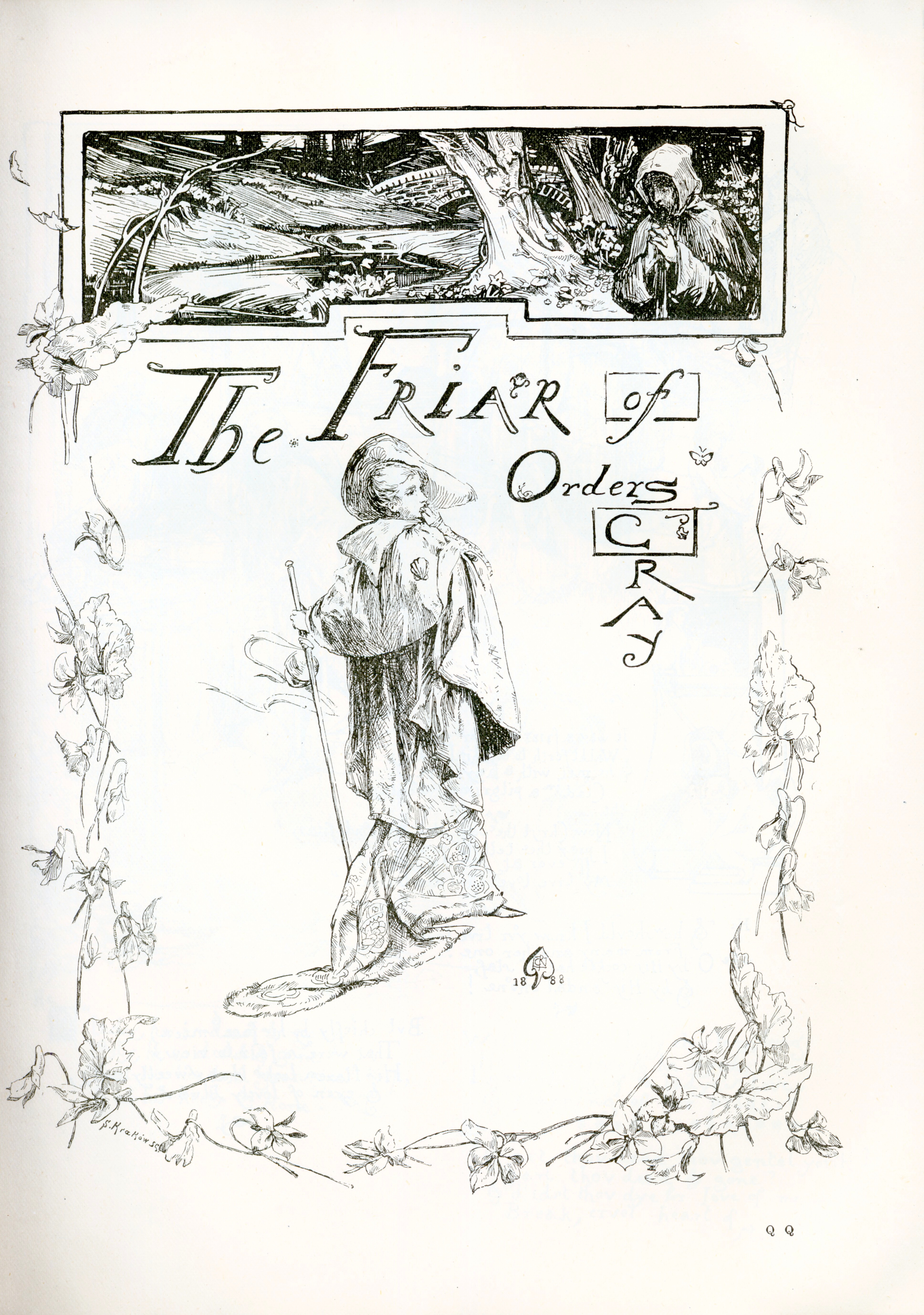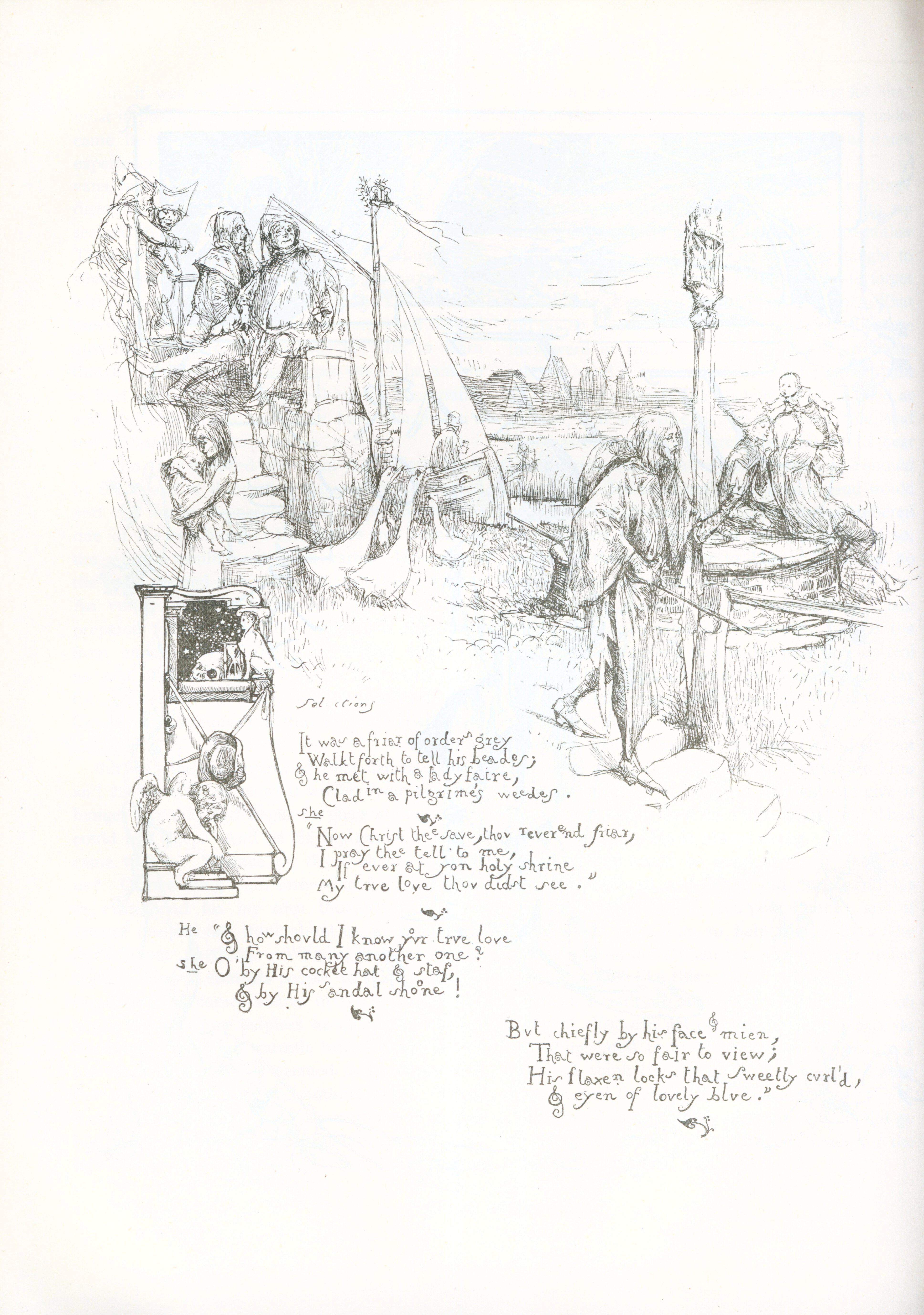A cloaked figure has its hands clasped on a staff. There is a bridge over a river
in the background, as well as trees and
various plants. Framed within a double-ruled rectangular border that runs the width
of the letterpress at the top of the page. A
border of leaves and cut flowers extends down from either side of the rectangular
frame, continuing across the bottom of the page.
Illustration borders the full page.
The Friar
of
Orders
G
r
a
y
A cloaked woman placed below the word “Friar” in the title. She is turned away from
the viewer but looks over her right
shoulder. She is holding a staff. 1/2 page.
The friar is walking down a set of outdoor steps. He is holding an open book in his
left hand and is reading it as he walks. A
group of people are sitting on a platform behind and to the left of the friar; one
man appears to be watching the friar. A woman
cradling a baby stands in front of the platform, as well as geese. There are more
people sitting on the platform of a large torch
directly behind the friar, one of which is holding another baby in the air. There
are nondescript buildings far in the background.
3/4 page. Typeface of the poem is hand-drawn and part of the same graphic unit as
the illustration. There are decorative fleurons
placed between the stanzas.
A cherub is crouched below a window that shows the night sky. On the windowsill are
a skull, an hourglass, and an Egyptian
statue of a sphinx. This illustration overlaps with the one above it. 1/8 page. Typeface
of the poem is hand-drawn and part of the
same graphic unit as the illustration. There are decorative fleurons placed between
stanzas.
Selections


It was a friar of orders grey1
Walkt forth to tell his beades;2
& he met with a lady faire,3
Clad in a pilgrime’s weedes.4
She
“ Now Christ thee save, thou reverend friar,5
I pray thee tell to me,6
If ever at yon holy shrine7
My true love thou didst see.”8
He
“ & how should I know your true love9
From many another one ?”10
She
“ O ’ by His cockee hat & staf,11
& by His sandal shoone !12
But chiefly by his face & mien,13
That were so fair to view ;14
His flaxen locks that sweetly curl’d,15
& eyen of lovely blue.”16

The friar is opening the door to a building with his left hand and is pointing at
the woman with the staff, who is seated on a
bench, with his right hand. The friar’s back is turned, but the woman faces forward.
3/4 page. Typeface of the poem is hand-drawn
and part of the same graphic unit as the illustration. There are decorative fleurons
placed around some stanzas. There is a
decorated initial letter “O” that begins one of the stanzas on the page.
He
O “ Lady, he is dead & gone !17
Lady, he is dead & gone !18
& at his head a green grass turf,19
& at his heels a
stone.20
Within these holy cloisters, long21
He languished & he dyed,22
Lamenting of a ladye’s Love,23
& playning of her pride.”24
She
“ & art thou dead thou gentel youth ?25
& art thou dead & gone ?26
& d’idst thou dye for love of me—27
Break, cruel heart of stone !”28

A partial border in the upper-left corner that connects two other illustrations on
the page. The inch-wide border depicts a
nude baby, a butterfly, and stylized flower petals. 1/8 page.
She
“ His cheek was redder than the rose29
The comeliest youth was he !30
But he is dead & laid in his grave31
Alas & woe is me !”32
He
“ Sigh no more, lady, sigh no more,33
Men were deceivers ever :34
One foot on sea, & one on
shore,35
shore,35
To one thing constant
never.36
never.36
A woman walking with two children. She has one child on either side of her and her
arms are wrapped around them. She is
looking back over her left shoulder at another child who is huddled over and sitting
on the ground. 1/4 page contained within a
rectangular border. Typeface of the poem is hand-drawn and part of the same graphic
unit as the illustration. Lines of the poem are
wrapped so that they fit between the illustrations. There are decorative fleurons
placed between and below some stanzas.
A group of women on a balcony watching boats that are below them. 1/4 page contained
within a rectangular border. Typeface of
the poem is hand-drawn and part of the same graphic unit as the illustration. There
are decorative fleurons placed between and below
some stanzas.
A kneeling cherub covering its face with its wings spread the width of the frame.
There are stylized flowers and petals around
it. 1/8 page contained in a rectangular border that is connected to the above illustration.
Hadst thou been fond, he had been false,37
& left thee sad & heavy ;38
For young men ever were fickle found,39
Since summer trees were leafy.”40
She
“ Now say not soe, thou holy friar,41
I pray thee say not soe :42
My love he had the truest heart43
O he was ever true !44
A genie’s lamp that is emitting smoke. There is a butterfly floating above the smoke.
1/8 page.

A group of children are playing outdoors in front of a tree. A woman sits on the ground
in front of the children; her head is
resting on her right hand. There are rabbits in front of the woman. There are nondescript
buildings on a mountain in the background.
There are flowers along the bottom of the page, as well as beside the poem. Typeface
of the poem is hand-drawn and part of the same
graphic unit as the illustration. There are decorative fleurons placed between and
below the stanzas. There is a decorated initial
ampersand that begins one of the stanzas on the page. Full-page illustration.
& art thou dead, thou much-Loved youth45
& didst thou dye for mee?46
Then farewell home ; for evermore47
A pilgrim I will be.”48
He
“ Yet stay fair lady; rest awhile49
Beneath this cloister wall :50
See through the hawthorn blows the cold wind,51
& Drizzly rain doth fall.”52
She
O stay me not, thou holy friar;53
O stay me not, I pray ;54
No Drizzly rain that falls on me55
Can wash my faults away.”56
He
Yet stay fair lady, turn again,57
& dry those pearly tears;58
For see beneath this gown of grey,59
Thy owne true-Love appears.60
But happly, for my year of grace61
Is not yet past away,62
Might I still hope to win thy Love,63
No Longer would I stay.”64
She
Now farewell grief, & welcome Joy65
Once more unto my heart ;66
For since I have found thee Lovely youth67
We never more will part.”68